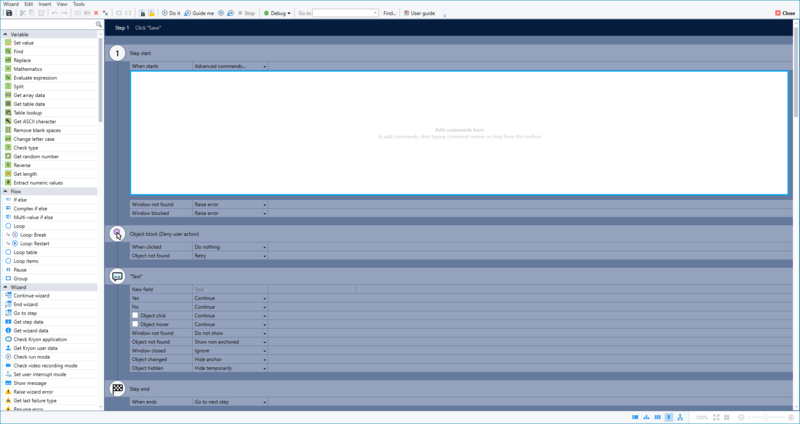Advanced commands
Advanced commands (AC) are a feature of the Nintex RPA Platform that allows you to add advanced logic to your automation wizards. These commands give instructions to the wizard to do different tasks such as getting and using data from external sources, interacting with external applications through read/write operations, executing scripts, and controlling the flow of the wizard using loops and conditions.
You have two options for incorporating advanced commands into your wizard:
-
Define commands in the Advanced commands editor: With the Advanced commands editor, you can create, configure, and customize advanced commands, defining the logic and actions for your tasks. This allows you to have full control over the functionality and behavior of the advanced commands.
 How to define commands in the advanced command editor
How to define commands in the advanced command editor
Access the advanced commands editor by selecting the advanced command view from the View Selector on the bottom of the Wizard Editor
 .
.
For information about how to access the Wizard Editor, see Creating a Wizard.
-
Invoke commands within the wizard: You can use these commands in your workflow by placing them at different stages in the wizard. This lets you perform complex tasks, get data from external sources, run scripts, control flow, and more. By using these commands, you can add advanced features without needing extensive programming knowledge.
 How to invoke commands within the wizard
How to invoke commands within the wizard
Advanced commands can be invoked from the following places in a wizard:
-
Step start: Triggers a predefined set of advanced commands when the step begins, even before the robot brings the window to the front and activates it.
-
Step end: Triggers a predefined set of advanced commands when the step is completed.
-
-
Bubble buttons: Triggers a predefined set of advanced commands when the user clicks a bubble button.
-
Bubble events: Triggers a predefined set of advanced commands when the user clicks or hovers over an anchored bubble object.
-
-
Fallback : Determines if the expected action failed and triggers advanced commands as a fallback accordingly.
-
Each advanced command typically consists of one or more variables and a logical action that is performed on those variables. This allows you to manipulate data, perform calculations, make decisions, and perform other advanced operations within your automation.
To learn more about the advanced commands and how to use each one, see the following table:
| Command Categories | Description |
|---|---|
| .NET Automation Commands | Perform text and value retrieval, as well as location information from objects within an active .NET Framework window. Also, set values for these objects in recorded steps. |
| AI-Powered Document and Text Analysis Commands | Leverage Microsoft Azure Cognitive Services for advanced document and text processing, including text retrieval, OCR, Form Recognizer, and Text Analytics. Requires a Microsoft license. |
| Block Commands | Control and restrict end-user interactions with the target application during wizard execution, preventing specific actions and defining logical flow. |
| Credentials Vault Commands | Securely insert Credentials Vault usernames and passwords, create new passwords, or revert existing ones for specified applications or general users. |
| Database Commands | Execute tasks such as monitoring changes in a database table, conducting SQL queries, and storing altered data in variables. |
| Date and Time Commands | Execute complex calculations and comparisons involving dates and times, guiding the logical flow of subsequent wizard steps. |
| Digital PDF Analysis Commands | Examine digital PDF files, extract text from pages, and store it in variables within an Analyze Digital PDF File container. |
| Flow Commands | Control the logical flow of the wizard, including conditional branching, loop management, and pausing command execution. |
| Interact with global variables, including retrieval, deletion, and management of values for use in other wizards. | |
| Mouse and Keyboard Commands | Automate keyboard shortcuts, text input, mouse interactions, and Caps Lock states. |
| Robotic Process Automation Commands | Add tasks to the queue, check task status, and obtain trigger inputs from files, folders, emails, and databases. |
| Scripting Commands | Enhance user experience with internal notes, variable lists, and debug messages during wizard execution. |
| Window Commands | Control and retrieve information for windows in the desktop environment, including window handles and state checks. |
| Wizard Commands | Manage and control wizards, including navigation, data retrieval, user management, and error handling. |